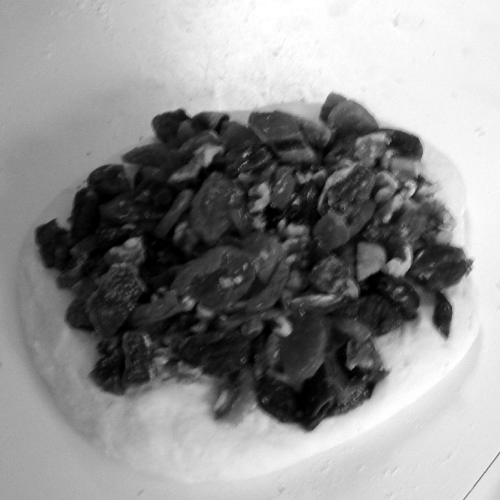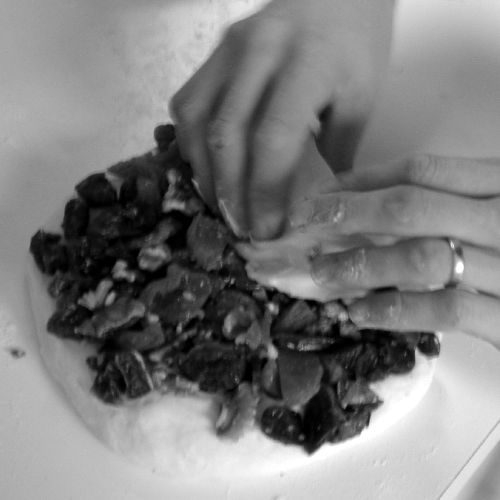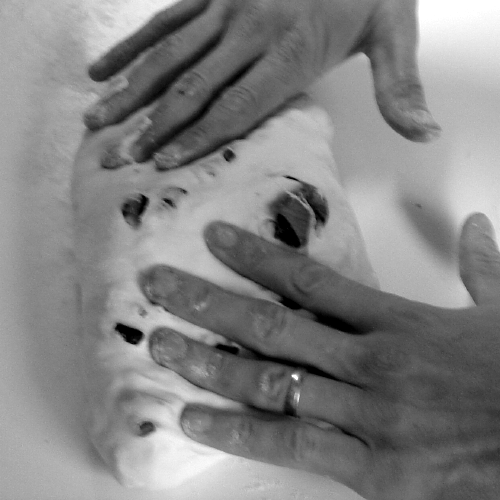The Sourdough Loaf
Although a longer process than making ordinary bread with dry yeast, the reputation that sourdough bread making is arduous or excessively time-consuming is unwarranted. It is true that from pulling the starter out of the fridge to eating the loaf can take on the order of 24-30hrs (under some approaches), the actual time the baker spends actively working on the loaf would not exceed 30min to 1hour in total. The work is short and very spread, usually before and after a sleep! A little planning means that the sourdough loaf can fit into even the tightest schedule.
Nevertheless, some things can't be faked, and the final sourdough loaf will carry the history of its making in the flavour, texture and crumb and therefore, some lead-processes are squarely undesirable (e.g. shortened proving).
In my experience, the most important variable is the overall length of the bread proving time. Some authors will recommend several hours, others full days, depending highly on the initial leaven to dough ratio. How will the loaf change? The main effect of longer or shorter overall prove times is the sourness -- the acidic content. This is simple to explain -- as the population of organisms spends longer in the water-flour rich environment, it will be exponentially increasing in number, and hence, in outputs of both CO2 and other bi-products like acids. The upside of longer proves is that the dough will first be more sour, and hence tasty, and second, the dough will 'respond' after a 'knock-down' (pushing most of the CO2 out) faster the longer the dough has been fermenting. The downside is that you will get progressively more sour dough until it is sickly sour, and as a consequence, the little yeast/bacteria mixture will have eaten so much of the flour that it will no longer be 'springy', and will instead become very slack and inelastic. This is not cool. A balance must be achieved.
Fortunately, unlike commercial yeasts where the difference between a good loaf and bad is a matter of an hour or so, sourdough is very forgiving -- since we're dealing with overall prove times of about 24 hours, an hour here or there that you miss due to staying out too long, or getting home from work late won't matter at all. Ironically, even though the process is long, this flexibility makes sourdough an easy process to fit in to life.
Side note: Ovens
A final word on ovens. As they say about oils -- 'ovens 'ain't ovens...' Experience is the best ally in this regard. However, some short-comings are treatable.
Recommended for all but the newest electronic style ovens, is to invest (~$7) in an oven thermometer -- then, you will know.
- Second, whether with a fan or not, many ovens suffer from over-shoot or generally poor thermal control dynamics (especially if opening and closing the door to spray the loaf). To this end, cook on a pizza-stone (~$15), pre-warmed with the oven, or -- as I have done thusfar with success -- place your largest, flat-based piece of crockery (e.g. lasagne dish) upside down on a low shelf and put your loaf directly on to this. Be sure to place either aid in the oven while it warms, this will provide both a steady heat-reservoir to control temperature cycles, and a much needed lower source of heat to rise the bottom portions of the loaf in the absence of good fan-forcing. Note, this will slow the warming of the oven. The oven is best if it is piping hot -- with a gas overn 15-20min pre-warming is usually fine, but with an electric at least 30min is required in my experience.
- Finally, it is worth investing further (~$3) in a water spray-bottle to maintain a moist atmosphere in the early stages of cooking. Some bread faults can arise if the oven atmosphere is too dry, though the main point is to keep the dough crust moist. This adds to the suppleness of the crust when the dough is expanding and also provides some moisture for the very good tasting surface reactions (Maillard reactions) of the sourdough loaf to occur. (That which gives the intense brown/black look to even plain sourdough loaves.)
Basic Components of the Wet Dough Loaf
Before laying out all the measurements, I'm going to first introduce the steps involved in making a loaf. The method below is an amalgam of different influences that I've had over time made up principally of: Richard McIntyre (Moorooduc Estate vineyard, Mornington Penninsula), Sonoma bakery (Sydney) and The Bread Builders (book).
The basic components of a 'wet-dough' sourdough loaf are as follows (note: not a recipe! see below for that):
- A quantity of starter (15-40% by weight of final dough);
- Flour and Water to make dough to 70-75b%;
- Salt (about 5g per 750g dough, to taste).
(We shall assume you have prepared a starter as above and have this in the fridge, ready to go.)
Building up the starter |
|||
 |
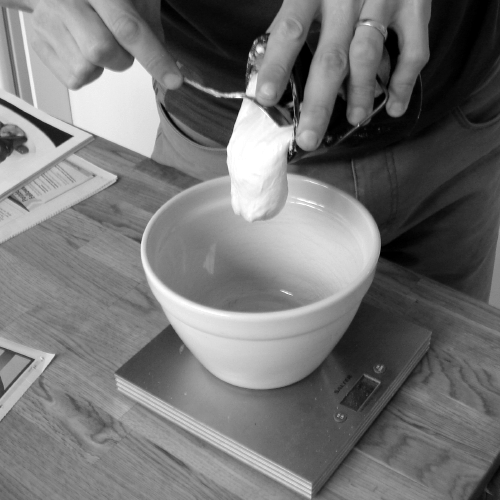 |
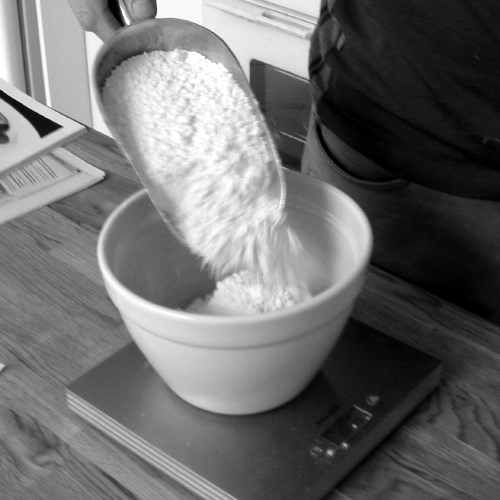 |
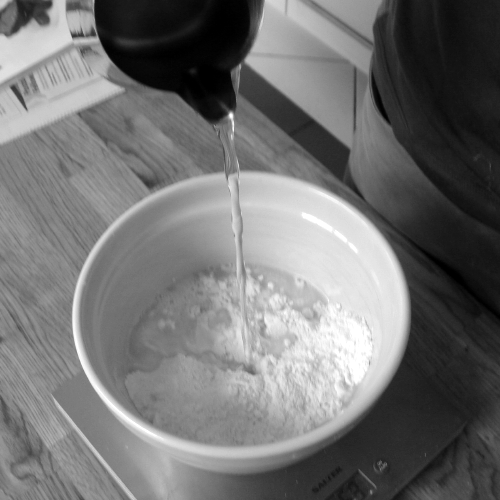 |
The starter pot |
Adding the starter |
Adding flour |
Adding Water |
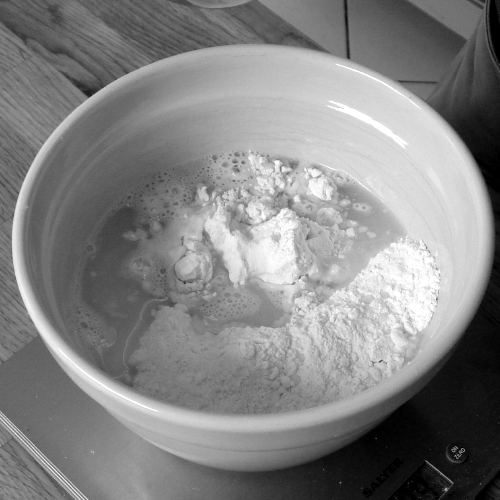 |
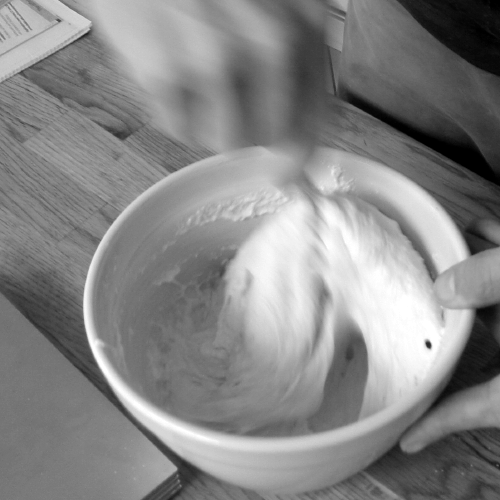 |
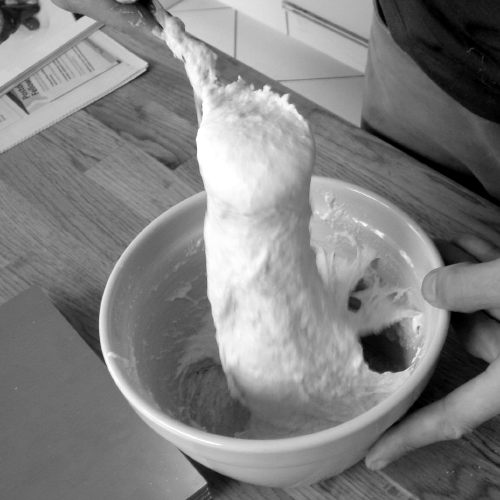 |
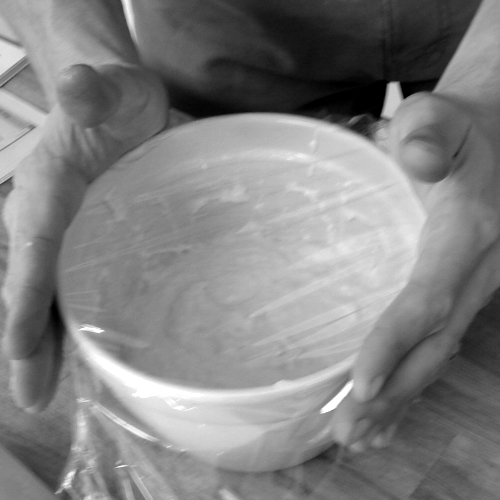 |
Prior to mixing |
Mixing |
The final mix |
Cling wrap it |
- Building up the starter
- Take the starter pot out of the fridge and take a good table-spoon of starter (or more) from your reserve pot and place in a small-medium bowl (NB: take less if it is smelling very potent). Add 1:1 ratio of flour and water, mix well. Leave for 8-12 hours.
Making the dough |
|||
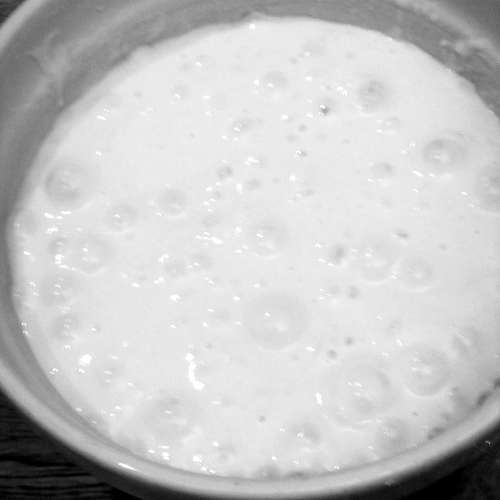 |
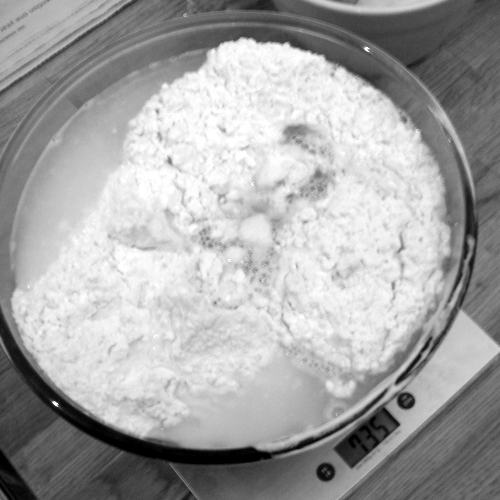 |
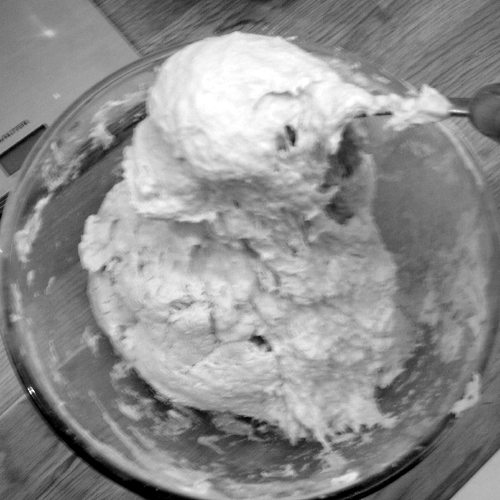 |
 |
The healthy leaven |
Prior to mixing |
First rough mix |
Saving some starter |
 |
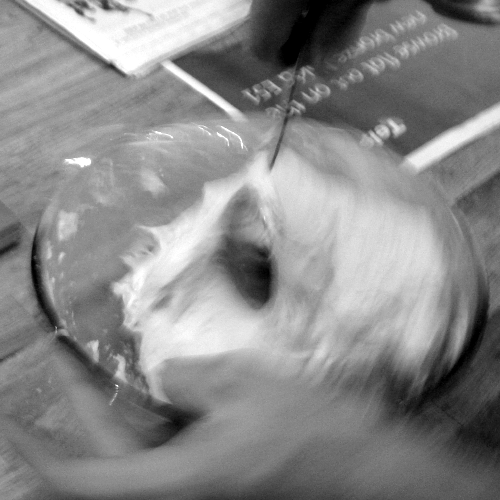 |
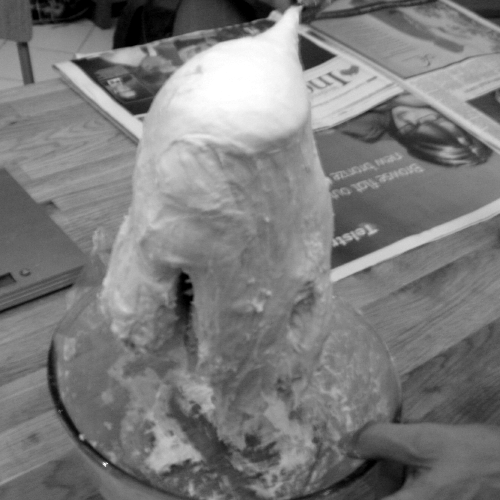 |
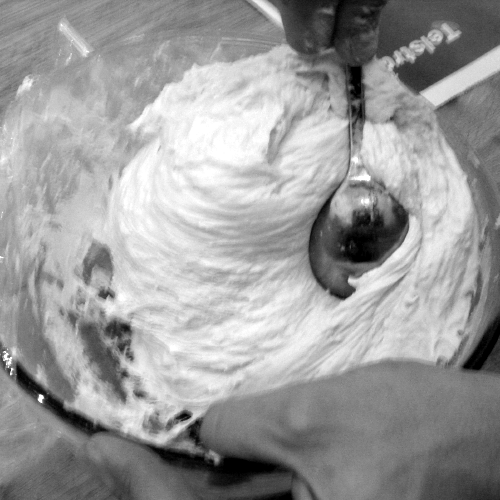 |
Adding the salt |
Second thorough mix |
Stretching the dough |
Forming the dough |
- Making the dough (1)
To the starter mixture add more flour and water as per recipe. Roughly combine to form a soft dough. Don't worry if it doesn't all mix. Rest for 10-30min. We are allowing the flour to expand and relax without the presence of salt. Don't forget to save some starter for next time!! Tip out the old stuff and put the excess new healthy starter into your pot for the fridge.
- Making the dough (2)
Add salt, mix again, now aiming for a smooth dough with all components well mixed. Take out of the bowl onto a slightly dusted bench-top if you like to give a quick need such that the dough is smooth. Miraculously, it should already have formed a reasonable structure (elasticity). Place back in bowl, cover with film and leave for 'a while'.
- First prove
(By the book, Sonoma style) Dough is left in the bowl with plastic-wrap covering for 2-3 hours. Over this time, again, dough will amazingly form a remarkable elasticity. To improve this, take a big spoon every so often and pass it under and through dough, letting whole dough mass fall slowly down either side of the dough in one long stretch. Gather and place back in bowl. (See 'Notes on Kneading' below)
Shaping the loaves |
|||
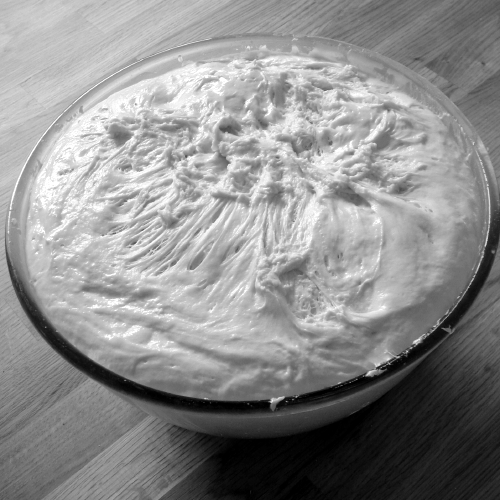 |
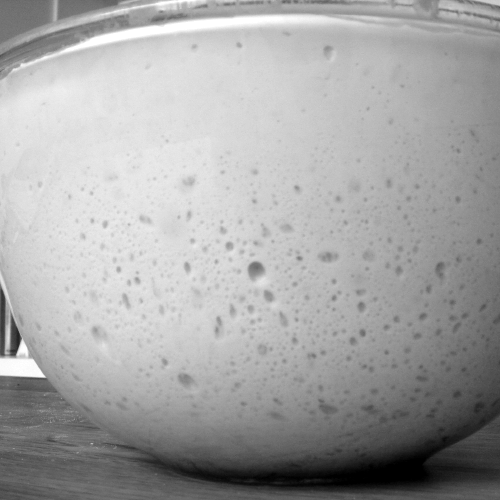 |
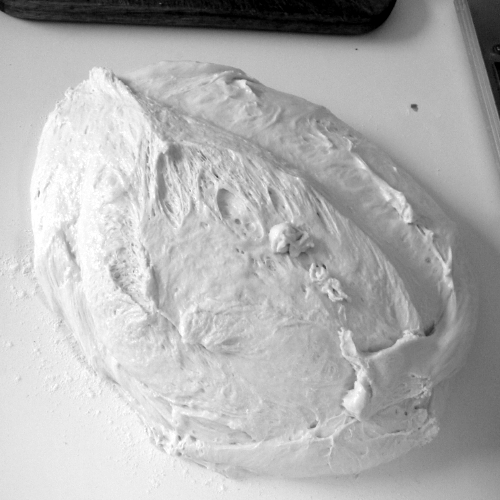 |
 |
After long prove |
Side view |
The full dough |
Cutting into pieces |
 |
 |
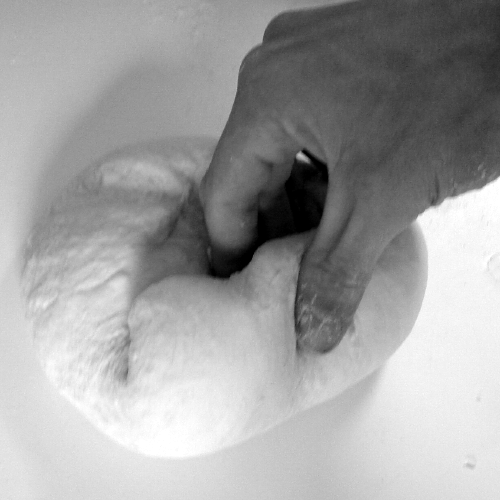 |
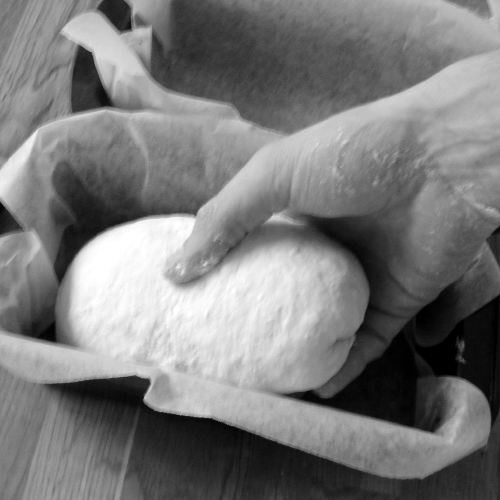 |
Three doughs |
Prepared tins |
Rolling for the tin |
Placing in the tin |
- Shaping
- The dough is turned quickly out onto a lightly dusted bench (a plastic scraper can be helpful for this). Knead lightly to form a managable dough. Have a small pot of flour nearbye to help with kneading, but don't use too much! Now split into loaf weight pieces by cutting with a sharp knife and using scales (e.g. 2 x 750g pieces). Knead each in turn, adding at this stage fruit if needs be. If forming for a tin, add structure and strength by flattening dough out with fingers and hands, and then rolling up tightly to form a thick log, tucking in the ends. Do the same for a 'free-form' loaf, if placing into a floured basket.
- Second prove
- The formed dough is placed in a suitable floured basket, on a bench in a floured tea-towel, or in a bread tin to prove for the second time for approximately 8-10 hrs;
- Prep oven
- About 30min before you wish to cook, warm the oven (with ceramic plate/pizza stone if needed) to approx. 230 degrees C plus, a thorough pre-warm is very important;
- Bake
- The dough should now have approximately doubled in size. If using tins, simply place the tin straight onto the shelf or plate to cook. If making a free-form loaf, turn dough (gently) directly onto the pizza stone or plate. the dough is turned out onto the plate in the oven, a liberal fine water spray is made in the oven cavity (not at the loaf), and slits are made in the top of the dough (all in quick, but safe, succession). Cook for 25-35min depending on oven, loaf should show good oven-spring and form. The loaf is ready when tapping on the base gives a hollow sound.
Notes on Kneading
Kneading the dough has a very special place in bread-making practice. It is assumed that the constant over-lapping and entwining action of kneading brings about that much prized 'springyness' in the final loaf. However, as will be described presently, not all kneading need be so active.
For the less hydrated doughs (up to around 72b%) you will find the dough has a smooth feel from the beginning. To knead this dough takes some care but is very rewarding. The kneading should be done in earnest (not over-doing it) just prior to forming the final dough shape for the second prove. However, with the wetter doughs (over 72b% .. approx.) you will find that the 'dough' is actually quite wet indeed, so much so, that sticking a finger into the mix will cause it to get 'gooped'. Richard McIntyre passed on to me the tip from a busy chef friend of his, who didn't mind this very wet and seemingly unstructured dough, infact, he all but got rid of the traditional kneading stage. The technique for these 'doughs' is that when mixed before the first prove, let the dough rest for 30min, and then with two hands (and a scoop such as a 'Baker's Friend') gather up all the dough and hold it over a bridge made by the outstretched fingers of both hands. The dough will fall very easily at first down either side in two long water-falls. Before the dough snaps, gather it again, and repeat. Do this a couple more times and then plonk back down into the bowl.
Return to the dough about every 20-30min for another two-three times over the first prove and repeat. If like me, you will be amazed to find that the once flowing dough will gradually form into a more 'normal' (but still quite moist) structured dough. The goop comes good. Once a sufficient dough is formed, leave for the rest of the prove. When turning out after the first prove, do some more 'traditional' kneading on a bench top, gathering in a sparing amount of fresh flour. Care must be paid to the way this kind of final dough is proved for the second time -- the tight roll approach is highly recommended, as is supplying the final dough with some side-support during the final prove (e.g. a bowl with steep sides, or on a tea-towel on the bench, between two flat surfaces (e.g. the wall and a large book)).
Notes on retardation
So what if you (like me) make a miscalculation with timings, or something comes up and you can't progress to the next step when you want to. .. Enter the fridge. Commercially, they don't have a 4C fridge, instead they have a 'retard' fridge which can be temperature controlled. Normally it is set to about 7C. The point is that longer doughs are usually better doughs. Good things take time. However, notice that the good thing about the length is that the flour and water get more and more well mixed and elastic. The downside is that if you were to let the dough just sit for a very long time you will allow the sourdough leaven to eat and eat and eat, eventually devouring any texture gains by leaving your dough sickly sour and lacking all structure. This is what the fridge is for. It also helps to standardise the commercial process since even a modern bakery building will likely experience 10-15C temperature changes due to the weather.
Since my fridge is at less than 4C (that's very cold) I like to think of the fridge sort of like a time-machine. For example, if I have got to Saturday morning following A1 (below) and am ready for the oven -- my doughs are nicely risen etc. but then I realise that I'm going on a 3 hour ride (say) .. then my doughs would almost certainly start to slacken if I just let them prove under normal conditions. Instead, I can just whack them into the fridge and when I get back from the ride, I pull them out, with the dough 'stuck' at 7am. Neat. This thinking works pretty well for fridge-stops of up to about 5 hours, but obviously, there is a low level of activity always occuring no matter what the temperature, so you can't 'stop' your leaven indefinitely. But it sure does help.
A Straight Sourdough Loaf
For this section, I present some initial sourdough timetables to get you started. As above, sourdough timing is actually very forgiving. Don't see the below as strict rules to follow, but rather as guides to the land less travelled -- it is up to you to explore and get to know the country. You will innevitably settle on some system that works for your situation.
Ingredients
(This is a (slightly) varied rendition of the Sonoma sourdough recipe)
To make two 750g loaves (1.5kg total dough weight)
- 250g starter*
- 720g organic unbleached flour
- 490mL water
- 10g salt
* starter assumed to be 100b% (i.e. 1:1) hydration
Let's see how the final dough matches up to the Baker's % test (for instruction):
Component |
Flour (g) |
Water (g) |
Component Weight (g) |
Starter |
125 |
125 |
250 |
Added Flour |
720 |
0 |
720 |
Added Water |
0 |
490 |
490 |
Totals (g) |
845 |
615 |
1460 |
So that is 615/845 = 73b%
Loaves for Saturday breakfast or lunch
(Or, The 24hour loaf)
A1. Sonoma-style Loaf, By the Book |
|||
Day |
Time |
Hrs |
Action |
Friday |
~ 9am |
0 |
Reinitiate starter |
~ 6pm |
9 |
Make dough, first prove |
|
~ 9pm |
12 |
(add fruit) Knead, shape, into tins/baskets, second prove |
|
Saturday |
~ 7am |
22 |
Warm oven |
~ 7:30am |
22.5 |
Transfer to oven, bake |
|
~ 8:00am |
23 |
Out of oven, cool |
|
~ 9:00am |
24 |
Eat! |
|
Notice that the above puts the 'short' prove first, the 'long' prove second .. you can make an 'upside down loaf' by reversing these.
A2. Sonoma-style Loaf, Upside Down |
|||
Day |
Time |
Hrs |
Action |
Saturday |
~ 12pm |
0 |
Reinitiate starter |
~ 9pm |
9 |
Make dough, first prove |
|
Sunday |
~ 7am |
19 |
(add fruit) Knead, shape, into tins/baskets, second prove |
~ 10am |
22 |
Warm oven |
|
~ 10:30am |
22.5 |
Transfer to oven, bake |
|
~ 11:00am |
23 |
Out of oven, cool |
|
~ 12:00pm |
24 |
Eat! |
|
To make a fruit loaf
At the shaping stage, combine with a handful (don't hold back) of your choice of favourite dried fruits and nuts such as:
- dried apricots;
- dried figs;
- dates;
- chopped walnuts.
- Hot Tip
Replace the organic flour with spelt flour to make a "Spelt Fruit Loaf". Spelt is more expensive (expect to pay up to $8/kg!) but makes an excellent fruit loaf for breakfast toasting. It is a light flour, with good low-gluten properties for gluten intolerant people (though not low enough for those with Celiacs).
To make a light rye loaf
Replace up to 30% of the added plain flour with rye flour. This will make the dough harder to work (more sticky, usually). You will probably need to keep more dusting flour (plain) on hand, plus some extra water to balance proportions as you knead the loaf. However, a good dough is still obtainable. I prefer this for toast since the rye combines with the sourness to make an excellent, tangy combinatation.
Variations
Other variations abound: * rye and sunflower seed; * honey and oat; * etc.

